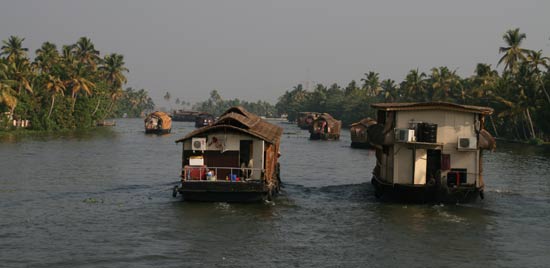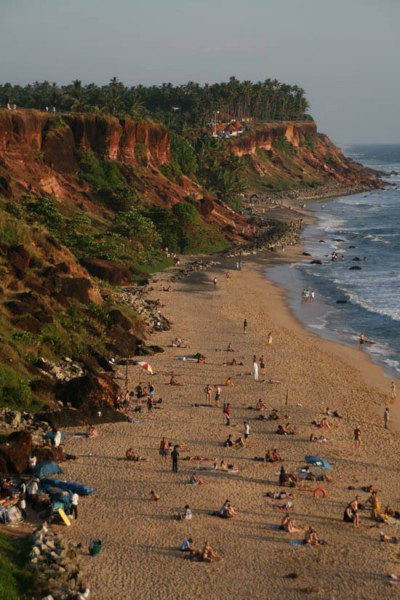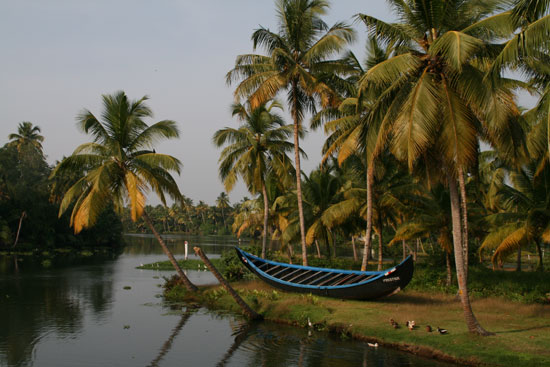Kerala Houseboats are a wonderful way to travel the beautiful Kerala backwaters. In Part 1 of Kerala Houseboats – The Essential Guide we explained what Kerala houseboats are, in Part 2 we let you know what to expect on a houseboat trip, and in Part 3 we talked about the sights and sounds you’ll experience on your journey. Now, in Part 4 we discuss the practicalities of booking your houseboat trip.
Where is the best place for a houseboat trip?
The most popular place to book a houseboat trip is Alleppey (also known as Alappuzha). There are hundreds of houseboats here, so you’re sure to find a boat that meets your needs, and the competition keeps prices low. However, the rivers around Alleppey can get crowded with other houseboats which can ruin the tranquil mood. The further you get from Alleppey the fewer other boats you’ll see.
Houseboats travel slowly at 40-50 kilometres (25-30 miles) a day. You can choose to either return to the place you started, or travel to another town.
Kollam (Quilon) is also a good place to book your houseboat trip. We booked a trip here from Kollam – Alleppey. The advantage of this route is that there are far less houseboats around – we only saw a few others until we reached the houseboat traffic jam coming into Alleppey.

Kerala houseboat traffic jam near Alleppey
Kumarakom (near Kottayam) is another popular houseboat spot, with the Alleppey-Kumarakom trip particularly scenic.
If you really want to avoid the crowds then head off the beaten track to the northern backwater area Valiyaparamba, 50km north of Kannur. The only other boats you’re likely to see here are traditional fishing boats.
How do I book Kerala houseboats?
There is no need to book a houseboat trip in advance, in fact you’ll get the best prices if you don’t. Even in peak season there are plenty of houseboats available, especially from Alleppey.
You’ll need to arrive in town the day before you want to take your houseboat trip. You can then either go down to the jetty or talk to your hotel/guesthouse about arranging a trip. The most important thing is to make sure you see the boat that you’ll be travelling on. Do negotiate the price (especially in off-peak season), and try to get your agreement in writing. You can also ask around for recommendations from other travellers.
What length trip should I take?
By far the most popular length houseboat trip is overnight for 22 hours, largely due to the cost involved. Some people say they would have been bored on a longer trip, but we didn’t want our trip to end and would have loved another night.
If you can afford it, and have books, journals or games to keep you occupied, then consider a longer trip. Some people even hire a boat for a week, and stop off to explore backwater towns and villages along the way.
How much will a houseboat cost?
The price of an overnight houseboat trip ranges from 6000 – 12,000 rupees (US$123-247 / GB£ 75-150). The cheapest trips are Alleppey-Aleppey. You’ll pay more for longer distance trips, more bedrooms, air conditioning and deluxe boats. It’s also more expensive during the peak mid December-mid January season, and much cheaper during the summer monsoon months.
We paid 10,000 rupees for a 2 bedroom non a/c houseboat from Kollam-Alleppey in mid December.
Are there any budget alternatives?
If you can’t afford to hire a private houseboat you could share a 2 or 3 bedroom houseboat with other travellers to reduce costs.
If this is still too expensive then you can explore the backwaters by canoe, which can be very rewarding, inexpensive and you’ll be able to access smaller canals that houseboats can’t.
You can also take a local ferry which is extremely cheap and you have the chance to interact with the locals. Alleppey – Kumarakom is a scenic route that takes 2.5 hours.
More information on different options is available in our post on the Best Ways to Experience the Kerala Backwaters.
The fifth and final part of our Kerala Houseboats guide explores the environmental impact of houseboats, and answer the commonly asked question “Is it worth it?” You can receive new articles direct to your reader by signing up to our RSS feed.



